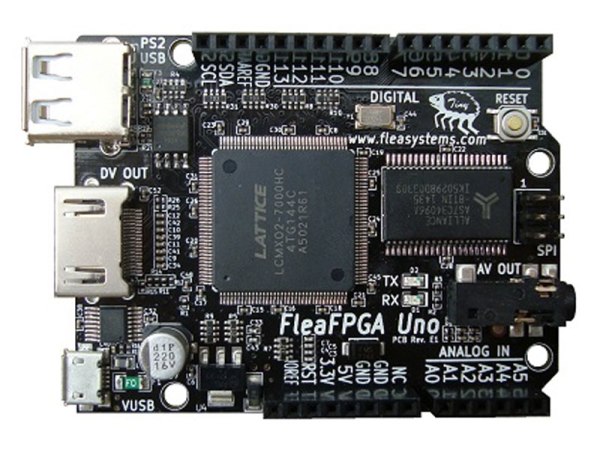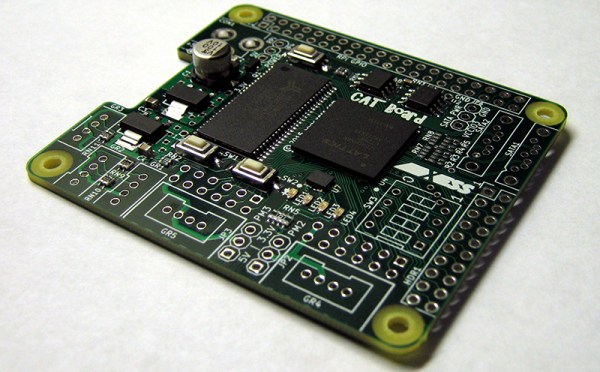Last time, I showed you a simple PWM block and an open source UART core. This time, I’ll put these parts together to create a PC PWM output peripheral.
fpga553 Articles
Taking The Pulse (Width Modulation) Of An FPGA
I like to think that there are four different ways people use FPGAs:
- Use the FPGA as a CPU which allows you to add predefined I/O blocks
- Build custom peripherals for an external CPU from predefined I/O blocks
- Build custom logic circuitry from scratch
- Projects that don’t need an FPGA, but help you learn
I’d bet the majority of FPGA use falls into categories one and two. Some FPGAs even have CPUs already built-in. Even without an onboard CPU, you can usually put a CPU “core” (think reusable library) into the chip. Either way, you can always add other cores to create UARTs, USB, Ethernet, PWM, or whatever other I/O you happen to need. You either connect them to a CPU on the chip, or an external one. With today’s tools, you often pick what you want from a list and then your entire project becomes a software development effort.
Continue reading “Taking The Pulse (Width Modulation) Of An FPGA”
Hackaday Links: November 29, 2015
The Raspberry Pi Zero was announced this week, so you know what that means: someone is going to destroy a Game Boy Micro. If you’re interested in putting the Zero in a tiny handheld of your own design, here are the dimensions, courtesy of [Bert].
[Ahmed] – the kid with the clock – and his family are suing his school district and city for $15 Million. The family is also seeking written apologies from the city’s mayor and police chief.
There are a lot — a lot — of ‘intro to FPGA’ boards out there, and the huge variety is an example of how the ‘educational FPGA’ is a hard nut to crack. Here’s the latest one from a Kickstarter. It uses an ICE40, so an open source toolchain is available, and at only $50, it’s cheap enough to start digging around with LUTs and gates.
Over on Hackaday.io, [Joseph] is building a YAG laser. This laser will require a parabolic mirror with the YAG rod at the focus. There’s an interesting way to make one of these: cut out some acrylic and beat a copper pipe against a form. A little polish and nickel plating and you have a custom mirror for a laser.
You know those machines with wooden gears, tracks, and dozens of ball bearings? Cool, huh? Tiny magnetic balls exist, and the obvious extension to this line of thought is amazing.
[David Windestål] is awesome. Completely and totally awesome. Usually, he’s behind the controls of an RC plane or tricopter, but this time he’s behind a slo-mo camera, an RC heli, and a watermelon. That’s a 550-sized heli with carbon fiber blades spinning at 2500 RPM, shot at 1000 FPS.
How do you label your cables? Apparently, you can use a label printer with heat shrink tubing. Nothing else, even: just put heat shrink through a label maker.
FleaFPGA + Arduino Uno = FleaFPGAUno
Some things are better together: me and my wife, peanut butter and jelly, and FPGAs and Arduino Unos. Veteran hacker [Valentin Angelovski] seems to agree: the FleaFPGA Uno is his latest creation that combines an FPGA (a Lattice MachX02 700HC) with an Arduino-compatible CPU.
It’s a step-up model from the origional FleaFPGA. With a few other components thrown in (such as a HDMI and composite video output and a WiFi option), you have a killer combination for experimenting with FPGAs or building an embedded system. That is because the Arduino part frees the FleaFPGA Uno from the breadboard: you can easily program, control and interface with the FPGA over a serial line or a wireless link using the Arduino IDE. There is even support for Arduino shields (albeit only 3.3V ones), making it even more expandable. This would be an awesome starting point for a retro gaming system, as many 8-bit consoles can be easily emulated in an FPGA. [Valentin] is currently selling the boards directly, and they are very reasonably priced at $50 or $60 for the WiFi version.
A Modern 386 Development Board
Some readers out there probably have nostalgic feelings for their first 386 based PC, the beeps and hisses of the modem, and the classic sound of a floppy drive’s stepper motor. Perhaps that turbo button that we could never quite figure out.
If you want the power of a 386 processor today, you’re in luck: [Pierre Surply] has developed a modern development board for the 80386SX CPU. This board is based on a 386 processor that comes in a LQFP package for “easy” soldering, and an Altera Cyclone IV FPGA.
To allow the CPU to run, the FPGA emulates the chipset you would usually find on a PC motherboard. The FPGA acts as both a bus controller and a memory controller for the CPU. On the board, there’s an SRAM chip and internal memory on the FPGA, which can be accessed through the 386’s bus access protocol.
The FPGA also provides debugging features. A supervisor application running on the FPGA gives debugging functionality via a FTDI USB to UART chip. This lets you control operation of the CPU from a PC for debugging purposes. The FPGA’s memory can be programmed through a JTAG interface.
The project is very well documented, and is a great read if you’re wondering how your old 386 actually worked. It can even be hand soldered, so the adventurous can grab the design files and give it a go. The francophones reading can also watch the talk in the video below.
Stuffing Macs Into FPGAs
A few years ago, [Steve] of Big Mess ‘O Wires fame stuffed one of the first Macintosh computers into an FPGA. While the project worked and was able to run System 6 on a virtual CPU, there were a few problems: it wasn’t exactly stable, and there was no support for a keyboard, sound, SCSI, or serial ports.
Now, there’s a new tiny FPGA board around, and this one is perfectly designed to fit the original Macintosh on it. It’s much more stable, and there is a floppy disk emulator on the horizon, just so you won’t have to deal with all those 400k 3.5″ disks anymore.
[Steve]’s brand new Mac Plus is based on the MiST board, an FPGA board that was originally designed to emulate the first Amigas and the Atari SE on an FPGA and a separate ARM CPU. There’s already been a lot of classic computers ported to the MiST, and the classic all-in-one Macs are the last project that’s left.
In the video below, you can see the MiST board running the classic System 6 at SVGA resolution. That means MacPaint and Shufflepuck in one compact board using modern hardware.
FPGAs For The Raspberry Pi
FPGA development has advanced dramatically in the last year, and this is entirely due to an open-source toolchain for Lattice’s iCE40 FPGA. Last spring, the bitstream for this FPGA was reverse engineered and a toolchain made available for anything that can run Linux, including a Raspberry Pi. [Dave] from Xess thought it was high time for a Raspberry Pi FPGA board. With the help of this open-source toolchain, he can program this FPGA board right on the Raspberry Pi.
The inspiration for [Dave]’s board came from the XuLA and StickIt! boards that give the Raspberry Pi an FPGA hat. These boards had a problem; the Xilinx bitstreams had to be compiled on a ‘real’ PC and brought over to the Raspberry Pi world. The new project – the CAT Board – brings an entire FPGA dev kit over to the Raspberry Pi.
The hardware for the CAT Board is a Lattice iCE-HX8K, 32 MBytes of SDRAM, a serial configuration flash, LEDs, buttons, DIP switches, grove connectors, and SATA connectors (although [Dave] is just using these for differential signals; he doesn’t know if he can get SATA hard drives to work with this board).
Despite some problems with his board house, [Dave] eventually got his FPGA working, or at least the bitstream configuration part, and he can blink a pair of LEDs with a Raspberry Pi and programmable logic. The Hello World for this project is done, and now the only limit is how many gates are on this FPGA.

















